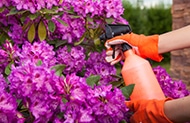
Integrated pest management does not eliminate chemical pesticides altogether. Rather, it combines different cultural, biological and chemical control methods to keep pest populations under control. By performing certain actions and planning, you can prevent pests from building up to populations to where they become a problem.
An example of integrated pest management to keep insects out of homes is pruning plant material and pulling the mulch at least 12 to 18 inches away from the structures.
Clean up food stuff in and around the house and store it in either the refrigerator or in sealed containers. Keep pet food from sitting outside overnight since it can attract raccoons, rodents, or other animals.

Resistance does not mean the plants are completely immune to pests, but they are less susceptible to pest attacks.
Pest problems can be brought under control by implementing proper cultural methods. Over fertilization of turf and plant material opens the door to numerous problems. On turfgrasses, it can increase the incidence of diseases, in particular, brown patch, a fungus that appears in the warm weather months causing brown dead rings of grass. On ornamental plants, excessive fertilizer usage can lead to succulent new growth that can attract aphids and other insects. Excessive amounts of water can cause root rot and other plant diseases. Any supplemental water applications should be made in the early morning hours. It will evaporate from the leaves during the day and will not be on the plant in the evening and night when conditions are more conducive to the development of diseases.
Other IPM methods can be as simple as the physical removal of pests such as washing aphids off with a hose or picking bagworms off infested plant material. Carefully observe the trunks of trees, the buds of flowering plants, the undersides of leaves and around your home for signs of pest activity. Routine monitoring will help you detect pests while they are in the early stages so you can take the appropriate tactics to reduce their potential damage.
These are some examples of integrated pest management methods. If the need to use chemical pesticides arises, make sure you have correctly identified the pest. An insecticide will control insects but will have no effect on a plant disease caused by a fungus. You need to select the right pesticide for the problem. Remember, when using pesticides READ ALL LABEL INSTRUCTIONS BEFORE USING PESTICIDES.
Integrated pest management, while not a silver bullet, can help reduce the pest problems in your home and garden. Many garden problems can be avoided by planning and understanding that pest infestations are often the result of a multitude of factors that will help keep problems to a minimum.
Timothy Daly is an Agricultural and Natural Resource Extension Agent with UGA Extension Gwinnett. He can be contacted at 678-377-4011or tdaly@uga.edu

